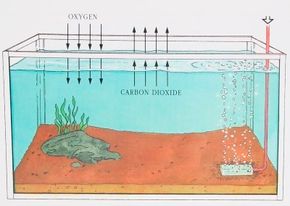Aquarium Aeration and Surface Agitation
Before looking at specific filter designs, you should understand aquarium aeration and surface agitation.
At the surface level, water and air undergo a natural exchange of gases. Oxygen goes from the air to the water, and carbon dioxide goes from the water to the air. This is how the oxygen that fish breathe enters their habitat and how the carbon dioxide that they produce by respiration is removed from their habitat.
Advertisement
When the surface of aquarium water is disturbed, the rate of gas exchange between the water and the air is increased; more carbon dioxide is released into the atmosphere and more dissolved oxygen is taken by the water. The surface tension of the water must be broken for sufficient gas exchange.
Fortunately, creating surface agitation is easily done with aeration, or pumping air into the water so that it forms bubbles. The bubbles rise to the surface and burst, thus breaking the surface tension.
This also creates water movement in the tank, in effect stirring the aquarium ever so slightly, so that all of the materials and compounds in the water -- both the beneficial ones and the harmful ones -- are evenly distributed throughout the tank.
One way of providing the necessary aeration in an aquarium is to use air stones connected to an air pump. The air stones can be made from wood or other highly porous materials. When air is forced in one end of the air stone by the pump, it is released as bubbles from the other end.
Many filters, however, use air bubbles as a part of their design. As air bubbles move upward, their movement causes water to rise up with them, in effect creating a current that circulates all the water in the tank. These air-lift filters use this technique to pull water through their filter media and thus clean the entire tank.
Any filter that uses air bubbles to operate will provide the aeration, as long as the bubbles are driven with enough air to actually break the surface tension of the water. Filters that do not use air bubbles to create circulation often have available attachments that provide aeration.
Go to the next page to learn about the different types of filter designs available.
